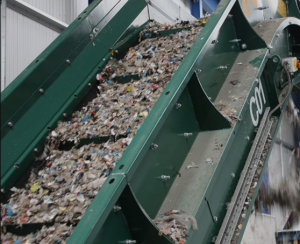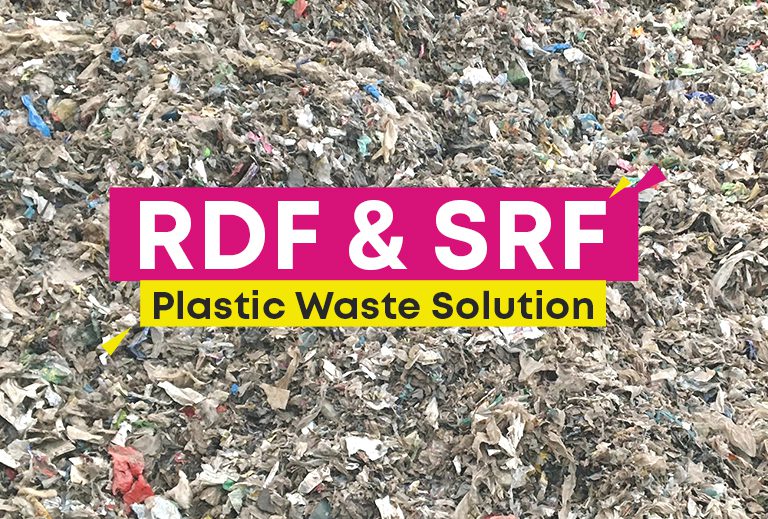Understanding The Potential Of RDF and SRF For Sustainable Plastic Waste Management
It’s been a little over hundred years since plastic was introduced and popularized across the globe. Mankind has spent a good part of the last few decades searching for the right way to dispose of plastic sustainably.
Over the years, many solutions were introduced to dispose of plastic waste in a manner that doesn’t impact human beings. We will explore two such solutions – Refuse Derived Fuel (RDF) and Solid Recovered Fuel (SRF) – in this article.

1. RDF – Refuse derived fuel:
It is a type of fuel created from different forms of waste such as commercial waste, industrial waste or municipal solid waste (MSW).
The waste used for RDF are often by-products that have a certain calorific value. In some instances, RDF that meets strict specifications can be put to use in applications that normally use fossil fuels such as coal.
Non-recyclable plastic is often used for RDF. It undergoes significant pre-processing involving steps such as screening, ballistic separation, air classification and separation of glass/metallic materials. This results in producing fuels of grain size that’s pelletized. This is then transformed into homogenous material that can serve as a substitute for fossil fuels in lime plants, cement plants and coal plants. RDF can also be used as a reduction agent in furnaces.

2. SRF – Solid Recovered Fuel:
It is a superior alternative to fossil fuel produced from commercial waste such as plastic, paper, wood, card and textiles. SRF goes through multiple processing stages to boost its quality and value. It boasts of a stronger calorific value than RDF and is used in cement kilns and boilers.
Depending on the quality and process used, SRF can replace up to 100% of fossil fuels used to create electricity or heat. However, current processes and equipment can produce in the range of 30 to 60% of fossil fuels.
SRF vs RDF: How different are they?
The primary difference between SRF and RDF is in the level of refinement of the final product. SRF undergoes a superior time-consuming process to reach its final state with the resulting material being high reliable as a stable fuel across industries. RDF, however, has inferior refinement and is not as efficient or reliable as a fuel.
RDF has excellent calorific value accompanied by low presence of chlorine. However, the exact composition of RDF is difficult to be ascertained because it is often not tested or prepared in a standardised manner. SRF, on the other hand, is produced by following European standard EN 15359. The standard ensures that SRF is produced by highlighting its calorific value, along with its chlorine and mercury content.
Among the two fuels, SRF is considered to be the fuel of the future. However, a lot more research must be done to standardise its refinement and burning capabilities.
You can look forward to more news about technology such as RDF and SRF by being a part of PLASTIVISION 2023. The spectacular event will be held from December 7 to 11, 2023 at Bombay Exhibition Center, Goregaon, Mumbai.
Some of the leading plastic-based companies from across the globe will be exhibiting at the event hosted by the All India Plastic Manufacturer’s Association. You can use the platform to make connections and showcase new products.
Call 022 6777 8846/48 / +91 99303 55494 or send an email to sanjeevani@plastivision.org to become a part of the event.
Leave a Reply Cancel reply
Recent Posts
- Understanding The Materials That Are Used To Build Plastic Toys
- All You Need To Know About Food-grade Plastics
- A Glance At The Materials That Boost The Performance Of Plastics
- Understanding The Importance Of Exploring New Business Opportunities In The Plastic Industry
- Understanding The Importance Of Investing in R&D For The Plastic Industry
Categories
- 3D Printing
- AIPMA
- Automation
- Automobile Sector
- Bio Plastics
- Environment
- Innovations In Recycling
- Latest Innovations
- Molds & Dies
- News
- Packaging Industry
- Plastic
- Plastic Application
- Plastic Industry
- Plastic Market
- Plastic Myths
- Plastic News From The World
- Plastic Packaging
- Plastic Products
- Plastic Recycling
- Plastic Solar Cells
- Plastic Toys
- Plastic Waste
- Plastic World
- Plastics
- Plastics And Their Applications
- Plastics In Agriculture
- Plastics In Healthcare
- Plastics In Medical Industry
- Plasticulture
- Processing Machinery
- Recycling Machines
- Robotics
- Uncategorized
- Virtual Reality
Archives
- November 2023 (3)
- October 2023 (2)
- September 2023 (3)
- August 2023 (3)
- July 2023 (3)
- June 2023 (3)
- May 2023 (2)
- April 2023 (2)
- March 2023 (2)
- February 2023 (2)
- January 2023 (2)
- December 2022 (3)
- November 2022 (1)
- October 2022 (1)
- September 2022 (2)
- August 2022 (1)
- July 2022 (3)
- May 2022 (3)
- March 2022 (2)
- February 2022 (1)
- January 2022 (1)
- September 2021 (2)
- August 2021 (3)
- July 2021 (4)
- June 2021 (4)
- May 2021 (3)
- April 2021 (2)
- March 2021 (4)
- November 2019 (8)
- October 2019 (8)
- September 2019 (8)
- August 2019 (8)
- July 2019 (8)
- June 2019 (8)
- May 2019 (8)
- April 2019 (8)
- March 2019 (8)
- February 2019 (11)
- January 2019 (8)
- December 2018 (8)
- November 2018 (12)
- October 2018 (12)

